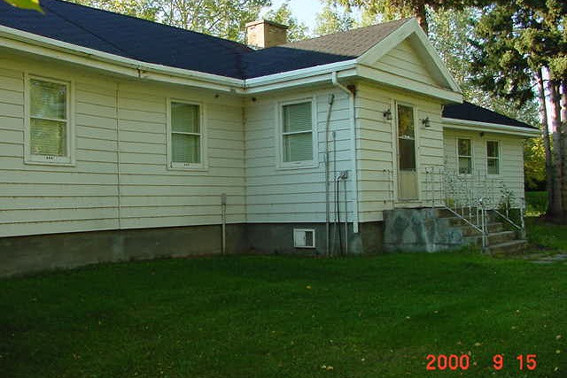Meanook (MEA) Magnetic Observatory

| Name | Meanook |
|---|---|
| IAGA alphabetic code | MEA |
| IAGA numeric code | 03247 |
| Geographic coordinates | 54.616° N, 246.653° E |
| Geomagnetic coordinates (IGRF-12 (2015)) | 61.17° N, 51.89° W (2015.0) |
| Elevation | 700 m |
| First year | 1916 |
| Observatory data | link |
For more information about IAGA, please visit the IAGA web site.
Meanook Geomagnetic Observatory was established in July, 1916. The site is 136 km north of the city of Edmonton, Alberta and 18 km south of the town of Athabasca.
The Observatory is located on the top of the plain to the west of Tawatinaw valley. The site is underlain by Upper Cretaceous sedimentary deposits to a depth of 2 km. The nearest railway passes through the bottom of the valley about 5 km southeast of the Observatory.
A recording basement to house Kew-type variometers was added to the original building in 1927. The absolute building and the heating system were renovated during 1940. In 1941 an annex to the basement recording room was constructed to house the two sets of LaCour variometers which had been located in a temporary hut since the International Polar Year (1932-1933). In 1951 the absolute instruments and LaCour variometers were transferred to a new magnetic observatory building. In 1955 an additional 215 hectares of land adjacent to the Observatory were purchased. Ground electrodes were established 1.6 km apart in north-south and east-west directions for the study of telluric currents.
Meanook Observatory was considerably expanded for the International Geophysical Year (1957-1958). In addition to the standard magnetic observatory, an auroral all-sky camera, an auroral intensity recorder, a patrol spectrograph a vertical incidence sounder, a fixed ionosphere backscatter sounder, a riometer and a telluric recorder were also in operation at the station. During the second International Polar Year the station consisted of only two buildings on a one hectare site; in 1957 the station possessed 15 buildings on a protected area of 219 hectares. Land and buildings no longer required for Earth Physics Branch (now part of the Geological Survey of Canada) programs were transferred to the Department of Public Works on 1 July, 1976. The 1951 magnetic observatory building and the old absolute building which still housed the optical variograph (RUSKA) were retained for the operation of the Meanook Geomagnetic Observatory. The old absolute building was demolished in 1988. The remaining building is centred in a 213 m by 213 m area reserved exclusively for the use of the Geomagnetic Program. The excess land is now in use by the Meanook Biological Research Station, University of Alberta.
Only declination was recorded from 1916 to August 1927, at which time horizontal force and declination differential photographic recorders of the Kew-type were installed. A vertical force magnetometer was installed in September, 1931. Standard and low sensitivity LaCour recorders replaced the Kew variometers in 1933. RUSKA variometers were installed in May, 1961 in the basement of the old absolute building. The RUSKA variometers were adopted as the standard recorders on 1 October, 1963. The production of optically recorded magnetograms was discontinued on 31 July, 1979.
Digital recordings of the geomagnetic field were begun in November, 1970 with the installation of the Earth Physics Branch's AMOS Mk I. The AMOS Mk I became the primary recorder for Meanook Observatory on 1 January, 1976. The aging AMOS Mk I was replaced by the AMOS Mk III in late November, 1980. In turn, the AMOS Mk III was replaced by the INTERMAGNET compliant CANMOS in mid-June, 1991.
CANMOS (Canadian Magnetic Observatory System) has been designed by the Geomagnetic Monitoring Service staff, who have developed the software to control the magnetometers and to process the basic digital data. CANMOS includes:
- a commercial tri-axial ringcore fluxgate magnetometer, mounted on a tilt-correcting suspension (of NRCan design)
- an Overhauser Proton Precession Magnetometer
- a bus-clock for timing control
- various storage media
- RS-232 outputs for 1 second, 5 second and 1 minute data streams
The AMOS MK I and III were instruments designed and manufactured by the then Dominion Observatory and Earth Physics Branch. These instruments differ significantly from a commercial version which was also named AMOS.